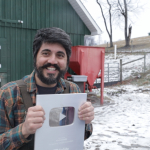Do you want a milk a cow on your homestead? Awesome!
Today I am going to show you, step by step, how I milk our cow on our Homestead.
Following these steps will help your cow stay healthy, help her avoid getting mastitis, and make sure her milk is safe for your family to drink.
The Setup

We milk our cow in a stanchion, allowing her to eat while being milked, and be held still.
Currently, I am using a machine for milking, but when I first started, I hand-milked her. This was due to the fact that I couldn’t afford any other method at the time, and I wanted to keep things simple.
One advantage of hand milking is that you need less equipment, making it less expensive to set up, and less to clean!
But you must have the right cow to hand milk.

Milking machines have many advantages. First, it is faster than hand milking. I can get four gallons of milk from our cow in just eight minutes. Another advantage of machine milking is that the milk is very clean, as long as the udder and teats are prepared correctly.
Now, I’ll walk you through the basic steps of setting up the milker.
The cow is milked by a ‘claw’ which is attached to her teats. (See FIG 1) Milk flows into the claw and out the bottom through the milk hose. Once the milk flows into the hose, it winds up in the stainless steel ‘bucket’.

To get the claw device to properly milk our cow, we need suction. This come from a vacuum pump, which is connected to an air hose, and that air hose is then connected to a pulsator device, located on the top of the stainless steel bucket.
The pulsator oscillates instead of providing a constant flow of suction to prevent any harm to the cow.
Each morning I enter the milk parlor, connect the claw, bucket and pump to each other with both milk and air hoses, and then bring the cow into the milk parlor.
Depending on the cow, now I will pour some feed into the feed trough. I use a mixed feed that we have made at the feed mill, but you can also purchase it at places like Agway, Tractor Supply, or any local feed mill if you’re looking for a dairy feed. I also add a little bit of beet pulp and Alfalfa pellets that the cow likes, since we’re not getting much grass right now and she’s only on hay. To ensure she gets the extra nutrition she needs, I give her these additional ingredients.
Everything is now set up, so I’m going to turn on the pump and start the milking process.
The pump – We found it on Craigslist and my husband was able to install it in the milk room through the ceiling. This surge pump provides the suction necessary to run the pulsator, which is a crucial component in milking the cow. I plug the pump in and it fires up, we are ready to milk.
Time to Milk the cow
Fancy, our cow, is familiar with the routine. We’ve been milking her once a day for the past three months, which is a relief after the twice-a-day regimen. She waltzes into the barn and right into her stanchion, and I close the head gate on her. The head gate is used to keep the cow in place during milking. This is essential because if the cow moves too much, the cow may step on the milk machine hoses and mess everything up.
If you want to build the same stanchion for your cow, we have a video that helps you do that.
The first thing I’m going to do when either hand milking or machine milking is put on gloves.
NOT because I’m afraid of what the cow can give me, more because I’m worried about what I can give the cow.
When we start milking, the cow’s teat ends are open, and touching them with contaminated hands can introduce bacteria and pathogens.
I put on the gloves because I don’t want to give her any staph infections that can permanently cause mastitis which are super hard to cure and will lead to either her being a three-quartered cow, a cow who can’t milk out of all four teats, or one who we have to put down because she just has chronic mastitis.
So, if there’s one thing you take away from this, it’s the importance of keeping your hands very clean when milking. You can either wash your hands before touching the teats or wear gloves, which will not cause any discomfort to the cow.
Remember, a calf’s tongue is very rough, your gloves are not. That said, it may be helpful to use a little salve for lubrication. If you need to strip the teats, you’ll need lubrication.
Don’t hesitate to wear gloves. I’ve heard many stories of people who didn’t wear gloves and their cow got staph or mastitis.
Next, I recommend using a teat dip in a non-return cup to make everything as clean as possible.
Before milking, brush off any hair or debris from the utter and use the teat dip.
Squirt out a few shots of milk to get rid of any impurities before putting on the milker.
Now it’s time to put the milker on.
If you’re milking with a machine for the first time, it may feel like wrangling an octopus, but with practice, it will become easier.
I attach the claw to the cow, and then step back and make sure everything is on correctly. She’s being milked out now.
To milk her out completely takes about four to five minutes. I can feel each quarter, at first they are very firm, full of milk, ready milked out.
Now if I feel them, they’re much more flabby, she’s been milked out.
I remove the claw, fancy is all done!
Once the claw is off, I post dip Fancy’s teats. If you’re leaving your calf on your cow, the calf will suck from the utter and will leave a lot of slobber on there.
That slippery saliva prevents bacteria from getting up inside the teat. However, we don’t have Fancy’s calf on her, so because the teat ends are open now and we don’t want any bacteria getting up in there, I post dip her.

Milking a cow isn’t hard, just a few key things you need to remember.
The most important being keep her clean, keep your equipment clean, Keep Your Hands Clean, and keep her utter clean.
After I finish up with the milking it’s time to head inside.
I get the milk inside, filter it, and chill it quickly.
Then I clean all the milking equipment. Thankfully I have hot water in the garage, it is nice having a dedicated milk sink out here just for storage of everything
It takes me 10 minutes to do the cleaning and get all the parts of the milk machine drying.
Now I can go inside, and have some milk and cookies!
If you think this looks awesome, having your own cow to go and milk, enjoying farm fresh milk every day, but you have some questions…
We have a class all about getting started with a family milk cow!
Milk Cow 101 – we’re going to give you a sneak peek into that entire class, click here to watch it!



There are many options on amazon to buy a milking machine. Do you have a recommendation of which brand or type?
for instance I see a “portable” machine which operates on batteries, vs a plug in.
Thanks for any help!
Hey Jeremiah, Sorry but we don’t have any experience with portable machines that are battery powered. I am afraid we can’t really help there.
nice information and good article thank you